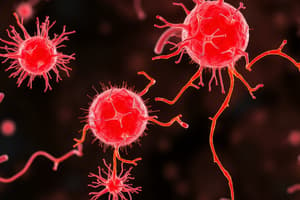Podcast
Questions and Answers
What is the primary goal of optimizing growth conditions in microbial ecology?
What is the primary goal of optimizing growth conditions in microbial ecology?
Maximizing product yields or biomass production
What environments do psychrophiles typically inhabit?
What environments do psychrophiles typically inhabit?
Cold ecosystems, such as Polar Regions, deep-sea environments, and cold terrestrial environments
What is the typical optimal temperature range for mesophilic microorganisms?
What is the typical optimal temperature range for mesophilic microorganisms?
Between 20°C and 45°C
What are examples of Gram-negative genera that are psychrophiles?
What are examples of Gram-negative genera that are psychrophiles?
What is the primary characteristic of thermophiles?
What is the primary characteristic of thermophiles?
What is the role of oxygen in aerobic respiration, and what type of bacteria strictly require oxygen for growth?
What is the role of oxygen in aerobic respiration, and what type of bacteria strictly require oxygen for growth?
Why is nutrient availability crucial in microbial ecology?
Why is nutrient availability crucial in microbial ecology?
How do increased levels of carbon dioxide affect the growth of certain bacteria, and what type of bacteria are specifically influenced by elevated CO2 levels?
How do increased levels of carbon dioxide affect the growth of certain bacteria, and what type of bacteria are specifically influenced by elevated CO2 levels?
What is the effect of oxygen on anaerobic bacteria, and what type of anaerobes can survive in the presence of oxygen?
What is the effect of oxygen on anaerobic bacteria, and what type of anaerobes can survive in the presence of oxygen?
What is the difference between obligate anaerobes and facultative anaerobes, and how do they respond to oxygen?
What is the difference between obligate anaerobes and facultative anaerobes, and how do they respond to oxygen?
What is the significance of nitrogen-fixing bacteria in the environment, and what process do they perform?
What is the significance of nitrogen-fixing bacteria in the environment, and what process do they perform?
How do anaerobic bacteria adapt to environments without oxygen, and what alternative pathways do they use for energy production?
How do anaerobic bacteria adapt to environments without oxygen, and what alternative pathways do they use for energy production?
What is the characteristic of most globular proteins in terms of water solubility?
What is the characteristic of most globular proteins in terms of water solubility?
Into how many major classes are proteins classified based on their structure and complexity?
Into how many major classes are proteins classified based on their structure and complexity?
What is the characteristic of albumins that distinguishes them from other proteins?
What is the characteristic of albumins that distinguishes them from other proteins?
What is unique about protamins compared to other proteins?
What is unique about protamins compared to other proteins?
In what solution are globulins soluble?
In what solution are globulins soluble?
What is the characteristic of conjugated proteins that distinguishes them from simple proteins?
What is the characteristic of conjugated proteins that distinguishes them from simple proteins?
How does pH influence the structure of proteins in bacteria?
How does pH influence the structure of proteins in bacteria?
What happens to bacterial growth in extreme pH values?
What happens to bacterial growth in extreme pH values?
How does pH affect the availability of nutrients for bacterial uptake?
How does pH affect the availability of nutrients for bacterial uptake?
What is the significance of pH in bacterial metabolic pathways?
What is the significance of pH in bacterial metabolic pathways?
How is pH used in food preservation to inhibit bacterial growth?
How is pH used in food preservation to inhibit bacterial growth?
Why is it essential to understand the pH requirements and tolerances of bacteria?
Why is it essential to understand the pH requirements and tolerances of bacteria?
What is the primary structure of a protein, and what does it determine?
What is the primary structure of a protein, and what does it determine?
What is the significance of the N-terminal and C-terminal amino acids in a polypeptide chain?
What is the significance of the N-terminal and C-terminal amino acids in a polypeptide chain?
What is the effect of a single alteration in the amino acid sequence of a protein?
What is the effect of a single alteration in the amino acid sequence of a protein?
What type of bonds are responsible for the folding of a polypeptide chain in secondary structure?
What type of bonds are responsible for the folding of a polypeptide chain in secondary structure?
What is the characteristic feature of the linear sequence of amino acids in a protein?
What is the characteristic feature of the linear sequence of amino acids in a protein?
Who is credited with presenting the primary structure of protein insulin for the first time?
Who is credited with presenting the primary structure of protein insulin for the first time?
Flashcards are hidden until you start studying




